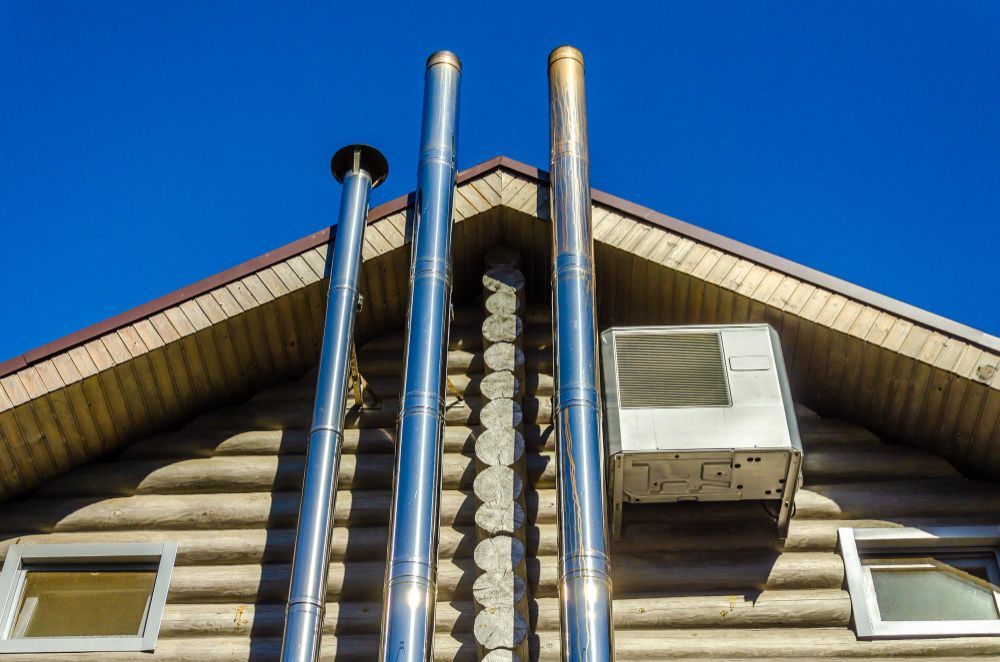(207) 975-5726
mymail@mailservice.com
What Causes Carbon Monoxide in a House? A Comprehensive Guide
I'll never forget the day my neighbor, Sarah, called me in a panic. Her family had woken up feeling dizzy and nauseous, with pounding headaches. Luckily, they realized something was wrong and got out of the house quickly. It turned out they had a close call with carbon monoxide poisoning due to a blocked chimney. This experience made me realize how important it is for all of us to understand what causes carbon monoxide in our homes.
Carbon monoxide is often called the "silent killer" because it's odorless, colorless, and can be deadly. As someone who's seen firsthand how scary a carbon monoxide incident can be, I want to share what I've learned about its causes and how to prevent it. Whether you're in Maine, New Hampshire, or anywhere else, this guide will help you keep your home safe.

Select Chimney Services
Waterproofing
- Protection from elements: Shields your chimney from rain, snow, and ice.
- Preventative maintenance: Helps avoid costly repairs due to water damage.
- Increased chimney lifespan: Extends the life of your chimney structure.
- Improved energy efficiency: Reduces heat loss through a damp chimney.
Stainless Steel Liners
- Fire safety: Provides a non-combustible liner to prevent chimney fires.
- Improved draft: Enhances the efficiency of your fireplace or wood stove.
- Durability: Resistant to corrosion and high temperatures.
- Customizable options: Available in various sizes and lengths to fit your chimney.
Demolition and Tuckpointing
- Chimney restoration: Repairs damaged or deteriorated chimney structures.
- Safety: Removes hazardous chimney components.
- Aesthetics: Improves the appearance of your chimney.
- Structural integrity: Reinforces the chimney for long-term stability.
Understanding Carbon Monoxide
What is Carbon Monoxide?
Carbon monoxide (CO) is a gas that's produced when fuels like gas, oil, coal, and wood don't burn completely. It's invisible and has no smell, which makes it particularly dangerous. In our homes, it can come from various sources that we use every day.
Why is Carbon Monoxide Dangerous?
The danger of carbon monoxide lies in how it affects our bodies. When we breathe it in, CO binds to our blood cells much more strongly than oxygen does. This means our body can't get the oxygen it needs, which can lead to serious health problems or even death if we're exposed to high levels or for a long time.
Common Sources of Carbon Monoxide in Homes
To keep our homes safe, it's crucial to know where carbon monoxide might come from. Here are the main culprits:
Fuel-Burning Appliances
Furnaces and Boilers
Our heating systems are one of the most common sources of carbon monoxide. If they're not working properly or are poorly ventilated, they can release CO into our homes.
Water Heaters
Just like furnaces, water heaters that use fuel can produce carbon monoxide if they're not functioning correctly.
Stoves and Ovens
Gas stoves and ovens can be a source of CO, especially if we use them improperly, like using a gas oven to heat a room.
Fireplaces and Wood Stoves
There's nothing quite like a cozy fire, but if our chimneys are blocked or our wood stoves aren't properly maintained, they can be a major source of carbon monoxide.
Portable Generators
During power outages, many of us turn to portable generators. But using them indoors or too close to the house can lead to CO buildup.
Vehicles in Attached Garages
Running a car in an attached garage, even with the door open, can allow carbon monoxide to seep into our homes.
The Silent Culprit: Chimney Blockage
As a homeowner in the Northeast, I've learned that chimney blockage is a particularly sneaky cause of carbon monoxide buildup. Let's dive deeper into this issue.
How Chimney Blockage Leads to Carbon Monoxide Buildup
Our chimneys play a crucial role in venting harmful gases, including carbon monoxide, out of our homes. When a chimney becomes blocked, these gases have nowhere to go but back into our living spaces. This blockage can happen gradually, making it easy to overlook until it becomes a serious problem.
Signs of a Blocked Chimney
Recognizing the signs of a blocked chimney can help prevent carbon monoxide buildup. Look out for:
- Soot or debris falling into the fireplace
- A strong, unpleasant odor coming from the fireplace
- Difficulty starting or maintaining a fire
- Smoke entering the room when a fire is lit
Importance of Regular Chimney Maintenance
Regular chimney maintenance is key to preventing blockages and ensuring proper ventilation. As someone who's dealt with chimney issues, I can't stress enough how important this is. A professional chimney service can identify and address potential problems before they become dangerous.
Preventing Carbon Monoxide in Your Home
Now that we understand the causes, let's talk about prevention. Here are some steps I've taken to keep my family safe:
Regular Appliance Maintenance
I make sure to have all my fuel-burning appliances serviced annually by a qualified technician. This includes my furnace, water heater, and gas stove.
Proper Ventilation
Good ventilation is crucial. I've made sure all my vents are clear and that my home has proper air circulation. This is especially important in areas with fuel-burning appliances.
Installing Carbon Monoxide Detectors
Carbon monoxide detectors are a must-have in every home. I've installed them on every level of my house, including near bedrooms. Remember to test them monthly and replace the batteries as needed.
Professional Chimney Inspections
After learning about the dangers of chimney blockage, I now schedule annual chimney inspections. A professional can spot issues that I might miss and ensure my chimney is safe and efficient.
What to Do If You Suspect Carbon Monoxide Exposure
Knowledge is power, especially when it comes to carbon monoxide safety. Here's what you need to know:
Recognizing the Symptoms
Carbon monoxide poisoning can mimic other illnesses, which makes it tricky to identify. Common symptoms include:
- Headache
- Dizziness
- Nausea
- Shortness of breath
- Confusion
- Blurred vision
- Loss of consciousness
If multiple people in your household experience these symptoms simultaneously, it could be a sign of carbon monoxide exposure.
Immediate Actions to Take
If you suspect carbon monoxide in your home:
- Get everyone out of the house immediately, including pets.
- Call emergency services (911) from outside the home.
- Don't re-enter the house until emergency responders give you the all-clear.
- Seek medical attention, even if symptoms seem mild.
Carbon Monoxide Safety in ME and NH
Living in Maine and New Hampshire, we face unique challenges when it comes to carbon monoxide safety, especially during our long, cold winters.
Local Regulations and Resources
Both Maine and New Hampshire have laws requiring carbon monoxide detectors in residential buildings. It's important to familiarize yourself with these regulations to ensure your home is compliant and safe.
For more information:
- Maine: Maine State Fire Marshal's Office
- New Hampshire: NH State Fire Marshal's Office
Finding Trusted Chimney Services in Your Area
Regular chimney maintenance is crucial in our region due to our heavy reliance on heating systems during winter. Finding a trusted chimney service in your area can make all the difference in keeping your home safe from carbon monoxide.
Conclusion
Understanding what causes carbon monoxide in our homes is the first step in preventing this silent danger. From maintaining our appliances to scheduling regular chimney inspections, there are many ways we can protect ourselves and our loved ones.
Remember, carbon monoxide safety isn't a one-time thing—it requires ongoing attention and care. By staying informed and taking proactive steps, we can create safer, healthier homes for ourselves and our families.
If you have any concerns about carbon monoxide in your home, don't hesitate to reach out to a professional. Your safety is worth it!
Key Takeaways
- Carbon monoxide is a colorless, odorless gas that can be deadly.
- Common sources include fuel-burning appliances, fireplaces, and blocked chimneys.
- Regular maintenance of appliances and chimneys is crucial for prevention.
- Install carbon monoxide detectors on every level of your home.
- If you suspect carbon monoxide exposure, leave the house immediately and call 911.
FAQs
- How often should I have my chimney inspected? I recommend having your chimney inspected annually, preferably before the heating season starts.
- Can I use a gas oven to heat my home? No, using a gas oven for heating can lead to dangerous carbon monoxide buildup. Always use proper heating appliances.
- Where should I place carbon monoxide detectors? Install detectors on every level of your home, especially near sleeping areas.
- How long does carbon monoxide poisoning take? It depends on the concentration of CO and exposure time. Symptoms can appear within minutes or hours.
- Can carbon monoxide travel through walls? Yes, CO can seep through drywall and small cracks, which is why proper ventilation is crucial.
- Is it safe to use a portable generator during a power outage? Only if used outdoors, far away from windows, doors, and vents. Never use generators indoors or in partially enclosed spaces.
- How can I tell if my chimney is blocked? Signs include difficulty starting fires, smoke entering the room, and soot buildup. When in doubt, contact a professional for an inspection.
Remember, when it comes to carbon monoxide safety, it's always better to be cautious. If you have any doubts or concerns, don't hesitate to reach out to a professional or learn more about chimney services. Your safety is the top priority!










Welcome to Select Chimney Services, your trusted partner for all your chimney needs in Union, ME, and surrounding areas. Our team of experienced professionals is dedicated to providing top-quality chimney cleaning, inspection, repair, and installation services tailored to meet your specific requirements. With a commitment to excellence and customer satisfaction, we ensure the safety and efficiency of your chimney system, allowing you to enjoy warmth and comfort with peace of mind. Contact us today to schedule an appointment and experience the difference with Select Chimney Services.
All Rights Reserved | Select Chimney Service
Quick Links:
- Home
- About Us
- Services
- Contact Us
Contact Information
Company Name: Select Chimney Services
Number: (207) 975-5726
Email: selectchimneyservices@gmail.com
Business Hours:
8:00 AM to 8:00 PM every day of the week
